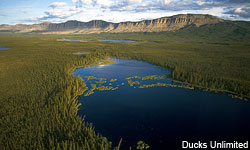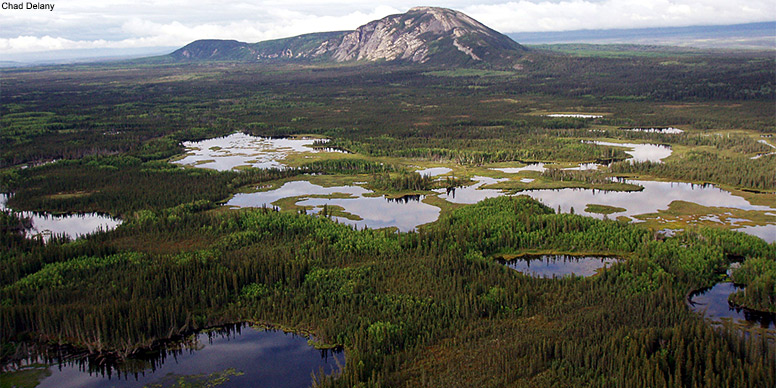Conserving the World's Last Great Forest Is Possible
The Canadian boreal forest is one of the world's great natural treasures. Stretching from the Yukon in the west to Newfoundland and Labrador in the east, this ecologically diverse region contains the largest blocks of intact forest and wetlands left on Earth. 
Scientists have found 1 billion to 3 billion nesting birds from 300 species in Canada's boreal forest. Its abundant wildlife and freshwater have sustained Aboriginal communities for millennia.
But the boreal is also rich in natural resources prized by a number of extractive industries. International forestry, mining, oil and gas, and hydropower corporations are all active in Canada's boreal.
The extent of boreal forestland already affected by extractive industries and their support infrastructures is roughly 730,000 square kilometers (180 million acres), an area larger than Texas. Yet, rules and regulations for managing extraction of resources have not kept pace with the rapidly expanding footprint of industry activities and their plans.
We feel very hopeful that Canada's boreal forest region will remain one of the world's great ecological treasures -Steve Kallick, Director, International Lands Conservation, The Pew Charitable Trusts
A Question of Balance
The question of how to balance conservation and economic development in the boreal has consumed countless hours of discussion among government officials, industry, and local community leaders. A report this week by an international panel of leading scientists, however, outlines a way forward.
The report—“Conserving the World's Last Great Forest Is Possible”—will be released at the annual meeting of the International Congress for Conservation Biology. It explores recent research on the health of the boreal and concludes with a set of clear, science-based guidelines for balancing conservation with development in the boreal.
Key guidelines detailed in the report include:
- At least 50 percent of the boreal forest region should be permanently protected from further development to maintain current ecological processes and wildlife species.
- Industrial activities on boreal lands outside of those where development is prohibited should be carried out with the lowest possible impact on biodiversity and the ecosystem.
- Land-use planning should precede decisions regarding industrial development in the boreal and must be led by local communities. Particular attention must be paid to the views and concerns of Aboriginal communities in the region.
- The impact of development and other industrial boreal land use should be rigorously monitored and regularly and meaningfully reviewed by independent experts.
“With mounting pressures on boreal regions of Canada, it is clear that maintaining the region's globally important conservation values will require very large protected areas,” said Dr. Jeff Wells, report co-author and science adviser to Pew's international boreal conservation campaign. “Ensuring that the identification and management of these areas is led by Aboriginal communities must be a priority.”

A Historic Opportunity
The panel also found a number of immediate opportunities where decision-makers could use current land-use planning initiatives and discussions to make significant conservation gains in Canada's boreal forest. Suggestions highlighted in the report include:
- Explore additional protections for boreal woodland caribou habitat. In 2012, the Forest Products Association of Canada deferred 283,000 square kilometers (70 million acres) within the boreal woodland caribou range from logging operations as part of the Canadian Boreal Forest Agreement. These areas should be considered for long-term protection status.
- Start boreal land-use planning in Ontario and Quebec. Provincial governments in recent years pledged to protect 50 percent of their northern regions. Aboriginal-led land-use planning should commence immediately to identify areas of 10,000 to 20,000 square kilometers (2.5 million to 4.9 million acres) that are ecologically most important. Areas excluded from ongoing forestry operations under the Canadian Boreal Forest Agreement should be given highest priority for consideration as protected areas.
- Accept new proposed protected areas in Quebec. Areas identified by the Cree between James Bay and Lac Mistassini, including the Broadback Valley region, should be accepted for protected areas designation. The Montagnes Blanches region within the Nitassinan of Mashteuiatsh and Pessamit also should be a priority for protection of its large intact forest blocks.
Time Is of the Essence
Time to protect the region and its unique ecosystem from potentially irreversible changes is growing short.
Woodland caribou have disappeared from the southern tier of the boreal. Most healthy wild Atlantic salmon populations now are found only in the undammed rivers of the boreal regions of Quebec and Newfoundland and Labrador. And scientists are raising concerns about the potential effects on the global climate from the release of carbon stored in the boreal forest's soils and plants.
But with proactive community-based planning and the use of clear scientific guidelines, conservation and development demands on Canada's boreal forest can be balanced.
“Canada's boreal forest region is one of the world's last great intact and pristine eco-regions,” said Steve Kallick, director of Pew's global wilderness programs. “Fortunately, many leaders in government, Aboriginal communities, and industry are implementing visionary ideas to balance conservation and development. We feel very hopeful that Canada's boreal forest region will remain one of the world's great ecological treasures.”
Read the full report, Conserving the World's Last Great Forest Is Possible: Here's How, on the International Boreal Conservation Science Panel website.






